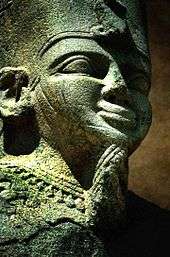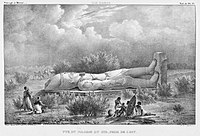Natakamani
Natakamani was a King of Kush who reigned from around or earlier than 1 BC to c. AD 20.[1][2] Natakamani is the best attested ruler of the Meroitic period. He was born to queen Amanishakheto.[3]

Monumental remains
Natakamani is known from several temple buildings and from his pyramid in Meroe. He is also known for restoring the temple of Amun,[2] as well as his dedication of the temple at Faras. On several monuments he appears together with co-regent Queen Amanitore. The relationship between the two is not clear: she might have been his wife, or his mother, who served as his regent while he was still young. However, it is known that during the co-reign, they had almost equal rights as depicted in several temple sculptures.[4] At the temple of Apedemak there is a relief showing him with his successor Arikhankharer.[5]
Natakamani was preceded by Amanishakheto and succeeded by queen Amanitore.
Historical images
 A statue that may depict Natakamani
A statue that may depict Natakamani Monumental Natakamani statue, as found in 1821
Monumental Natakamani statue, as found in 1821 Another statue of Natakamani, as found in 1821
Another statue of Natakamani, as found in 1821
See also
References
- Garlake Peter. (2002) Early Art and Architecture of Africa "Oxford University Press". p. 60. ISBN 0-19-284261-7.
- Oliver, Roland and Brian M. Fagan Africa in the Iron Age "Cambridge University Press". p. 40. ISBN 0-521-09900-5.
- Mokhtar, G. (2001) Ancient Civilizations of Africa "University of California Press". p. 168. ISBN 0-85255-092-8.
- Meade Teresa A. and Merry E. Wiesner-Hanks. (2004) A Companion to Gender History "Blackwell Publishing". pp. 259-60. ISBN 0-631-22393-2.
- Török, László (2002). The Image of the Ordered World in Ancient Nubian Art: The Construction of the Kushite Mind, 800 Bc-300 Ad. BRILL. p. 226. ISBN 978-90-04-12306-9.
- Török, László (2002). The Image of the Ordered World in Ancient Nubian Art: The Construction of the Kushite Mind, 800 Bc-300 Ad. BRILL. p. 226. ISBN 978-90-04-12306-9.